|
|
|
Sort Order |
|
|
|
Items / Page
|
|
|
|
|
|
|
| Srl | Item |
| 1 |
ID:
089362
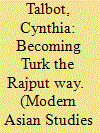

|
|
|
|
|
| Publication |
2009.
|
| Summary/Abstract |
The Kyamkhanis were a small Indian Muslim community who flourished in northern Rajasthan from c. 1450 to 1730. This article examines memories of the Kyamkhani past recorded in a seventeenth-century history of the ruling lineage, as a case study of both the process of Islamic expansionism in South Asia and the self-identity of rural Muslim gentry. While celebrating the ancestor who had converted to Islam generations earlier, the Kyamkhanis also represented themselves as local warriors of the Rajput class, an affiliation that is considered exclusively Hindu in India today. Their history was written in a local literary language, Braj Bhasa, rather than in the more cosmopolitan Persian that was widely used by Muslim elites at the time. The Kyamkhanis of the early modern era thus negotiated multiple social and cultural spheres, simultaneously participating in the local/vernacular as well as global/cosmopolitan arenas.
|
|
|
|
|
|
|
|
|
|
|
|
|
|
|
|
| 2 |
ID:
089367
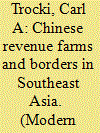

|
|
|
|
|
| Publication |
2009.
|
| Summary/Abstract |
This article examines the role of Chinese revenue farmers in defining the borders of the various colonial territories and the states of Southeast Asia during the nineteenth century. Their significance has largely been neglected in writing on the formation of state boundaries. Nicholas Tarling notes, 'Between the late eighteenth and the early twentieth almost all southeast Asia was divided into colonies or protectorates held by the Western powers, and new boundaries were drawn with the object of avoiding conflict among them' (Tarling, 2001:44). This paper argues that Chinese revenue farmers were of considerable significance in giving substance to the formalistic pronouncements of remote diplomats and statesmen.
|
|
|
|
|
|
|
|
|
|
|
|
|
|
|
|
| 3 |
ID:
089366
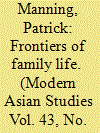

|
|
|
|
|
| Publication |
2009.
|
| Summary/Abstract |
Families, while usually thought of in local terms, also have their global dimension: some families stretch around the world, while families anywhere are affected by worldwide declines in mortality. This study addresses the local and global changes brought to family structures by migration. Through comparisons of five pairs of regions from the early modern Indian Ocean world and Atlantic basin, the study shows how migration created distinctive regional age and sex ratios. It also traces the flows of migrants between Atlantic and Indian Ocean and compares the intensity of migration in each zone. It argues that expanding migration reinforced familial mixing and family frontiers in virtually every region and every social grouping. The resulting complexity in family mixes often caused families to become smaller, yet brought new criteria (birthplace, colour, religion, etc.) for hierarchy and social order.
|
|
|
|
|
|
|
|
|
|
|
|
|
|
|
|
| 4 |
ID:
089364
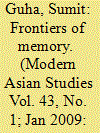

|
|
|
|
|
| Publication |
2009.
|
| Summary/Abstract |
The past two decades have seen a dramatic renewal of interest in the subject of historical memory, its reproduction and transmission. But most studies have focused on the selection and construction of extant memories. This essay looks at missing memory as well. It seeks to broaden our understanding of memory by investigating the way in which historical memory significant to one historical tradition was slighted by another, even though the two overlapped both spatially and chronologically. It does this by an examination of how the memory of the Marathi-speaking peoples first neglected and then adopted the story of the Vijayanagara empire that once dominated southern India.
|
|
|
|
|
|
|
|
|
|
|
|
|
|
|
|
| 5 |
ID:
089356


|
|
|
|
|
| Publication |
2009.
|
| Summary/Abstract |
The consolidation of the Delhi Sultanate coincided with the Mongol devastation of Transoxiana, Iran and Afghanistan. This paper studies the Persian literature of the thirteenth and fourteenth centuries invested as it was in the projection of the court of the Delhi Sultans as the 'sanctuary of Islam', where the Muslim community was safe from the marauding infidel Mongols. The binaries on which the qualities of the accursed Mongols and the monolithic Muslim community were framed ignored the fact that a large number of Sultanate elites and monarchs were of Turkish/Mongol ethnicity or had a history of prior service in their armed contingents. While drawing attention to the narrative strategies deployed by Sultanate chroniclers to obscure the humble frontier origins of its lords and masters, my paper also elaborates on steppe traditions and rituals prevalent in early-fourteenth-century Delhi. All of these underlined the heterogeneity of Muslim Sultanate society and politics in the capital, a complexity that the Persian litterateurs were loath to acknowledge in their records.
|
|
|
|
|
|
|
|
|
|
|
|
|
|
|
|
| 6 |
ID:
089365
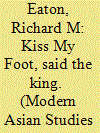

|
|
|
|
|
| Publication |
2009.
|
| Summary/Abstract |
The little-known Battle for Raichur (1520), waged between Krishna Raya of Vijayanagara and Sultan Isma'il 'Adil Shah of Bijapur, saw a number of firsts in South Asian history: the earliest significant appearance of cannon-whether used offensively as field artillery, or used defensively on the battlements of forts-the earliest known appearance of matchlock firearms, and the first significant use of European mercenaries. It followed the merging of new gunpowder technologies after engagements between Portuguese and Ottoman navies off the Konkan coast. Notably, the side that lost the battle, Bijapur, had the superior firepower. The essay also explores the extraordinary round of diplomacy that followed the battle and the humiliating demands Krishna Raya imposed on the defeated sultan. These demands, and the military and diplomatic manoeuvres that accompanied them, likely sowed the seeds for Vijayanagara's spectacular defeat and destruction forty-five years later, at the Battle of Talikota.
|
|
|
|
|
|
|
|
|
|
|
|
|
|
|
|
| 7 |
ID:
089360
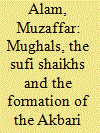

|
|
|
|
|
| Publication |
2009.
|
| Summary/Abstract |
This essay places Mughal-Sufi relationship within a larger sixteenth century context, focusing on the strategies the early Mughals adopted to build their power in India. It reviews the positions of the two important sufi groups, the Indian Chishtis and the Central Asian Naqshbandis, juxtaposing the political benefits or the loss that the Mughals saw in their associations with them. While the Naqshbandi worldview and the legacy of the legendary Ubaid Allah Ahrar clashed with their vision of power, in the Chishti ideology, on the other hand, they found a strong support for themselves. The Chishtis then had an edge at the time of Akbar. But the Naqshbandis under Khwaja Baqi Billah (d. 1603) continued in their endeavour to reinstate their place in Mughal India. The paper thus provides a backdrop and makes a plea for re-evaluating the debate on the ideology and politics of Shaikh Ahmad Sirhindi (d. 1624).
|
|
|
|
|
|
|
|
|
|
|
|
|
|
|
|
| 8 |
ID:
089363
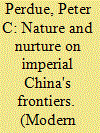

|
|
|
|
|
| Publication |
2009.
|
| Summary/Abstract |
Ecologies of production and state classifications shaped Chinese imperial frontier policies. In Chinese classical debates about the effect of environment on human character, the dominant view held that all peoples could become civilised, but a dissenting view held that barbarians could never change their ways. Nomadic pastoralists likewise debated whether to adopt certain Han cultural practices or reject them. Chinese dynasties often accepted diversity, but at certain times tried to eliminate difference by persuasion or by force. Three cases illustrate these processes during the Qing period: the relationship between Manchus and Mongols, Qing policies towards aboriginal peoples and the settlement of Taiwan, and Qing policies towards southwestern mountain peoples. In each case, policies came out of the interaction of ethnic categorization, views on cultural transformation and frontier environments. When Qing rulers lost the ability to recognise such cultural distinctions, they lost a key to the endurance of the empire.
|
|
|
|
|
|
|
|
|
|
|
|
|
|
|
|
| 9 |
ID:
089361


|
|
|
|
|
| Publication |
2009.
|
| Summary/Abstract |
This essays deals with a neglected and significant strand of Indian political thought by describing and analysing the corpus known as n?ti in the context of medieval and early modern South India (in particular with reference to the Telugu-speaking region). Works of n?ti are presented here within a larger context, as they evolve from the medieval Andhra of the Kakatiyas into the Vijayanagara period, the Nayakas, and beyond. They are also opposed and contrasted to other texts written within the broad category of dharmash?stra, which seem to deal with a far more conservative project for the management of society and politics within a caste-based framework. Authors and compilers dealt with include Baddena and Madiki Singana, but also the celebrated emperor-poet Krishnadevaraya (r. 1509-29). An argument is made for the continued relevance of these texts for the conduct of politics in South Asia, into and beyond the colonial period.
|
|
|
|
|
|
|
|
|
|
|
|
|
|
|
|
| 10 |
ID:
089359


|
|
|
|
|
| Publication |
2009.
|
| Summary/Abstract |
While trade in opium was of limited financial significance in the eighteenth century to the larger accounts of the Dutch East India Company as a whole, this article shows its critical importance to the Company's comptoir accounts at Batavia. The article examines the VOC's commercial operations at Batavia in the eighteenth century and places opium trade and ipium revenues within that larger context. It examines how the trade in Bengal opium through Batavia changed over time, based on a statistical analysis of the Company's accounts.These results show that opium dwarfed all other individual or groups of commodities that were available to the Company to sell profitably on Java and in the Indonesian Archipelago over the long eighteenth century.
|
|
|
|
|
|
|
|
|
|
|
|
|
|
|
|
| 11 |
ID:
089358


|
|
|
|
|
| Publication |
2009.
|
| Summary/Abstract |
This article looks at the political economy of opium smuggling in India in the first decades of the nineteenth century, in particular in relation to Sindh, one of the last independent polities in the subcontinent. After a description of the smuggling of 'Malwa' opium (grown in the princely states of Central India) into China-in defiance of the monopoly of the East India Company over 'Bengal' or 'Patna' opium, grown in Bihar-it considers the role of Indian merchants and capitalists in its emergence and development, and critiques the argument put forward in a recent book by Amar Farooqi that it represented both a form of 'subversion' and that it contributed decisively to capital accumulation in Western India. This article concludes by analysing the role of the opium trade in integrating Sindh into the British imperial trading system, arguing that it was more effective in boosting Empire than in nurturing indigenous capitalism in India.
|
|
|
|
|
|
|
|
|
|
|
|
|
|
|
|
| 12 |
ID:
089357


|
|
|
|
|
| Publication |
2009.
|
| Summary/Abstract |
India and China were the most important producers of textiles in the world prior to the industrial revolution. However, whereas the Western historiography usually discusses Indian cotton and Chinese silk in connection with European imports, or with their sales in the Indian Ocean and the Middle East, cotton and silk were also exchanged between India and China. Indeed, Indian cotton and Chinese silk were probably the principal manufactured goods exchanged between these civilizations. Although Indian records are fragmentary, especially when compared with the voluminous Chinese sources, Indian cotton goods are known to have reached the Indianized states in Xinjiang in the early Common Era (CE), and may have been produced there, in Khotan and the neighbouring states, by the time that indigenous silk production was known to exist in India in the fourth and fifth centuries CE. Yet, while in later centuries large amounts of cotton cloth were produced in China while indigenous centres of silk production developed in India, exchanges of the finest types of cotton and silk cloth continued, usually driven by cultural and social factors in each civilization.
|
|
|
|
|
|
|
|
|
|
|
|
|
|
|
|
|
|
|
|
|